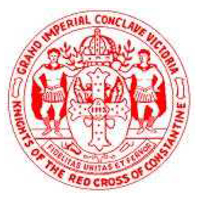Browse Our Directory
Directory of masonic orders that operate in Victoria, Australia.

Masonic and Military Order of (RCC)
The Red Cross of Constantine and Orders of Holy Sepulchre and St John the Evangelist
Brief History
One of the defining moments in the history of Western civilis-ation was the vision that led Constantine to victory at the battle of Saxa Rubra, when his forces defeated those of one of his rival emperors, Maxentius.
This in turn led to Constantine’s acceptance of Christianity and his imposition of it on the whole Roman Empire.
The most famous and dramatic account is that of Eusebius, Bishop of Caesarea who related in a speech to celebrate 30 years of Constantine’s reign in 336 that the day before the battle of Saxa Rubra (27 October 312), Constantine was praying, and begging God to reveal Himself.
As he prayed, at around midday, a “most marvellous sign” appeared in the sky. A cross of light appeared, above the Sun with the inscription In hoc signo vinces (In this sign, thou shalt conquer).
Constantine and his entire army of close to 100,000 men were amazed at the sight.
That night, Eusebius reports, Constantine had a dream. In his dream, Christ appeared to him and ordered that Constantine make a “likeness of that sign which he had seen in the heavens” and use it as a protective in all his future battles.
This was the Labarum, which was to become the Imperial Standard of the Roman Empire and Constantine chose 50 young knights- Knights of the Red Cross of Constantine-the earliest Military Order of Knighthood in history, to guard it.
The Masonic Order of the Red Cross, Holy Sepulchre and St. John can trace its introduction into England from 1788 and in 1808 the Order of the Red Cross of Constantine was recognized in London with a new Constitution under the name of “Illustrious Order of the Red Cross”.
In 1825 Robert Carlile published an ‘Exposure’ in England that contained a Degree called the “Order of the Red Cross of Rome and Constantine,” and the ritual is strikingly similar to that being used today.
In 1865, Robert Wentworth Little established the Grand Council and the Order spread with great speed across the globe.
Organisation
The Order in Victoria meets in 10 Conclaves and an Annual Assembly is conducted in June to enthrone the Grand Sovereign and Grand Viceroy and invest Grand Officers.
A separate Grand Body exists in every State of Australia apart from Tasmania.
Qualifications
Qualifications for membership are Craft Master Mason and Royal Arch Mason and require members to follow the trinitarian Christian faith.
Degrees
The ceremonies are solemn, dramatic and of deep mystical significance and many Masonic historians and thinkers have seen the Order of the Red Cross of Constantine and its associated Orders as not only the Third Great Pillar of Christian Masonry but the climax of Christian Freemasonry.
The order has five degrees:
Knight of the Red Cross of Constantine: This degree relates the well-known story of Constantine the Great, the Roman Emperor who was miraculously converted to the Christian faith.
It tells of his divine vision, the institution of a special standard, his subsequent victory over the rival Emperor Maxentius and the creation of what is claimed to be the oldest institution of Christian Knighthood.
The substance of the degree develops around the secret doctrine associated with the Labarum, the banner of victory, while the lecture contains a most interesting reference to the Roman College of Architects.
All regular business of the Conclave is conducted in the degree of the Red Cross of Constantine, while the Sanctuary and Commandery are only for the purpose of conferring the Appendant Orders.
Knight of the Holy Sepulchre: Tradition asserts that this degree originated after the discovery of the true Cross by St Helena. It is concerned with the three days which intervened between the Crucifixion and the Resurrection.
This Order of Chivalry is said to have been instituted by the mother of Constantine, to maintain a guard at the Holy Place and is symbolised in the ceremony by a vigil over the HS.
The duties enjoined on the Knights were the performance of the seven works of mercy.
Knight of St John the Evangelist: This is the second of the Appendant degrees which are always conferred together and is founded upon a tradition, recounted by Philostorgius ( about 400 AD) concerning a remarkable discovery made at the ruins of the Temple at Jerusalem and the subsequent foundation of the Knights of St John.
The interpretation of the legend is of a most interesting and instructive nature and is striking in its attempt to explain the Craft and Royal Arch ceremonies in a purely Christian sense.
Essentially, it is the Old Testament Royal Arch arrayed in Christian dress and denotes our faith in the Trinitarian doctrine. The Appendant Orders are preparation for The College of ‘Priests-Mason’ which is only open for Knights who are an Eminent Viceroy of a Conclave.
The Priests- Mason represent the Bishop Eusebius. The Degree of Priests- Mason then is preparation for The Senate of ‘Princes-Mason’ which is only open to Most Puissant Sovereigns of a Conclave.
The Princes-Mason represent Emperor Constantine.
2 The Lowry Conclave
Meeting: 2nd Thursday at 7:30pm (meets odd months, no meeting in January) at Ringwood
Enthronement: March
6 Maroondah Conclave
Meeting: 5th Saturday at 5:00pm (no meeting in December) at Ringwood
Enthronement: First 5th Saturday
7 The Byzantium Conclave
Meeting: 2nd Saturday at 10:15am (meets February, April, September, November) at Sunshine West
Enthronement: 9:30am in November
9 Light Of The World Conclave
Meeting: 2nd Monday at 7:30pm (meets May, July, September, November) at Wonthaggi
Enthronement: 6:30pm in May
10 St. Helena Conclave
Meeting: 2nd Wednesday at 7:30pm (meets February, April, October) at Belmont
Enthronement: 6:45pm in October
11 St. Matthew Conclave
Meeting: 1st Friday at 7:30pm (meets February, April, August, October) at Stawell
Enthronement: 7:00pm in October
